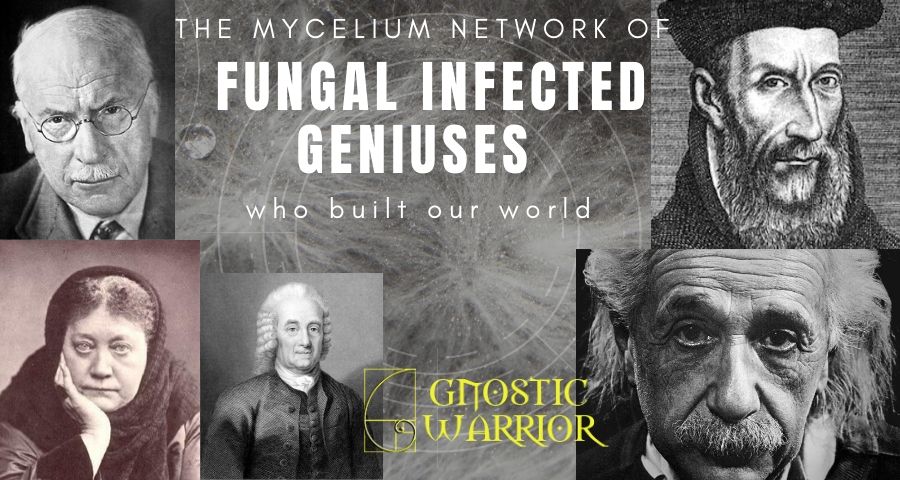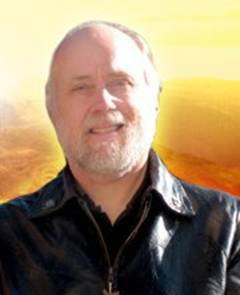In researching some of the world’s most famous geniuses who have ever lived, I have discovered that many of them share a particular trait that seems to connect them to one another as if they are all part of the same network of super-intelligent fungi.

A world-wide-web of knowledge and memories via a secret mycelium channel of interconnectedness that only certain initiated/infected humans can access.
This access point I theorize is made not by us, but by them and it is through the very symbiotic microorganisms who inhabit our bodies and the world that we obtain our intelligence, religion, laws, governmental policies, and prophecies.
In this article, I would like to share with you some of my research into some of these legendary mental giants showing that they were ALL sick with some type of illness or disease which I believe was the result of a fungal infection.
An ancient of knowledge and wisdom that I contend that these alien fungi have preselected certain humans as their mediums and prophets of whom some I name below.
What I have also discovered is that some of the people who recover and or eternally suffer from childhood or adult illnesses will often go on to become divinely inspired and intelligently gifted healers who have this newfound ability to freely share their knowledge and heal others.
In a later paper, I will delve into the science as to why I believe that illness and disease will either bring out the inner genius angel or the evil demon within us all.
Here is a list of the most famous and smartest people to help prove my theory.
NOSTRADAMUS
Perhaps the most famous on my list is the 16th-century French astrologer and physician Michel de Nostredame (Nostradamus). He is well known around the world for his prophecies and also being one of the most sought after doctors during the plague.
Nostradamus is considered to be a prophetic giant who has been credited with accurately predicting future events, including the rise of Hitler.
He was also sick from gout and arthritis for much of his adult life and suffered from dreams and nightmares that gave him visions of the future. Nostradamus lived at the royal court in Paris at the queen’s invitation until his illness forced him to return to Salon.
He eventually lost his first wife and children to the plague which sent him into a deep depression.
Nostradamus’ illness was said to later develop into edema or dropsy, where abnormal amounts of fluid accumulate beneath the skin or within cavities of the body.
He had predicted his own death on the evening of July 1, 1566, when Nostradamus is alleged to have told his secretary Jean de Chavigny, “You will not find me alive at sunrise.”
The next morning he was reportedly found dead lying on the floor next to his bed.
VOLTAIRE
The 17th-century French Parisian scientist and philosopher, Francois Marie Arouet, better known as Voltaire, was one of France’s greatest writers and philosophers who suffered a life long illness that he often remarked about in his writings.
Throughout Voltaire’s life, he was said to have an obsession with his illness and his erotic desires are inextricably linked in his many works and claims his illness for resulting in his illicit passion for his niece.
Voltaire left the court for good in 1753, supposedly telling a friend, “I was enthusiastic about [Frederick] for 16 years, but he has cured me of this long illness.”
He ended up living a fairly long life until he died at age 83.
I will leave you with a famous quote by Voltaire — “The art of medicine consists of amusing the patient while nature cures the disease.”
HELENA BLAVATSKY
One of the world’s most famous Russian occultist was born prematurely in 1831 at “midnight” in the Ukraine as a cholera epidemic raged. She was born to a royal family and immediately baptized as a sleepy child holding a candle had accidentally set fire to the officiating priest’s robes.
The woman’s name was Helena Petrovena Blavatsky. She was the granddaughter of General Alexis Hahn (a noble family of Mecklenburg settled in Russia) and her mother was Helene Fadeyef, and the granddaughter of Privy Councillor Andrew Fadeyef and of the Princess Helene Dolgoruki. It was said that she was called Sedmichka, meaning one connected with the number seven.
As early as 1860, it was reported that Helena suffered from a terrible illness from a wound near her heart that would not fully heal and would re-open occasionally making her suffer in great agony. Her sickness would last for a few days and then heal suddenly and no trace of it remains.
In 1864, Helena had another serious illness that had often rendered her comatose. Later that year she connected with a family friend named Isidore at the Metropolitan of St. Petersburg who had blessed Helena with the following words:
“As for you let not your heart be troubled by the gift you are possessed of, nor let it become a source of misery to you hereafter, for it was surely given to you for some purpose and you could not be held responsible for it. Quite the reverse, for if you but use it with discrimination, you will be enabled to do much good to your fellow-creatures.”
It was said that she was restored back to life again where she began her travels again going to Italy but while traveling in Europe, back in India, some jealous Theosophical Society employees with forged documents that they brought to the police filed trumped-up charges of fraud against her. The charges were later dropped but the stress associated with the investigation from her former colleagues had wreaked havoc on Madame Blavatsky’s health.
By the end of March 1887, she again fell gravely ill with a kidney infection and was not expected to live.
From the statements made by her relatives and recorded in her own words, no doctor could understand her illness.
It was said that after he last bout of that illness, Helena repeatedly told her friends—” to lead a double life.”
In his Incidents in the Life of Madame Blavatsky (p. 147), Mr. Sinnett quotes a written description of hers of a ” double life ” she led throughout a certain ” mild fever,” which was yet a wasting illness, that she had when a young lady in Mingrelia:
“Whenever I was called by name, I opened my eyes upon hearing it, and was myself, my own personality in every particular. As soon as I was left alone, however, I relapsed into my usual, half-dreamy condition, and became somebody else (who, namely, Mme. B. will not tell). . . . .
In cases when I was interrupted, when in my other self, by the sound of my present name being pronounced, and while I was conversing in my dream-life, —say at half a sentence either spoken by me or those who were with my second me at the time,—and opened my eyes to answer the call, I used to answer very rationally, and understood all, for I was never delirious. But no sooner had I closed my eyes again than the sentence which had been interrupted was completed by my other self, continued from the word, or even the half word it had stopped at.
When awake, and myself, I remembered well who I was in my second capacity, and what I had been and was doing. When somebody else, /’. e., the personage I had become, I know I had no idea of who was H. P. Blavatsky! I was in another far-off country, a totally different individuality from myself, and had no connection with my actual life.”
It was as if Helena was describing another conscious entity that inhabited her physical body.
In March 1887 March, with failing health, exhausted, she fell into another coma from which she was revived yet again in order to finish her last masterpiece, The Secret Doctrine.
On May 8, 1891, after many years of chronic illness, the Royal Russian Madame died in London.
CARL JUNG
Swiss psychiatrist and founder of analytical psychology, Carl Jung said that at age 38 he started having visions and hearing voices.
Jung described his visions as a type of “psychosis” or “schizophrenia” that would worry him but also produce much of his material for the Red Book that was published after his death.
The New York Times describes the story told by the Red Book:
The book tells the story of Jung trying to face down his own demons as they emerged from the shadows. The results are humiliating, sometimes unsavory. In it, Jung travels the land of the dead, falls in love with a woman he later realizes is his sister, gets squeezed by a giant serpent and, in one terrifying moment, eats the liver of a little child.
At age 69, he had a heart attack that kept him at death’s door for several weeks while he went deep within to a world of visions.
Not surprisingly, Jung’s mother, Emilie, was haunted by mental illness most of her life.
ALBERT EINSTEIN
The German physicist Albert Einstein (1879-1955) suffered from chronic illness for much of his adult life and had mental developmental issues as a child.
He suffered from many health problems such as digestive system disorders; liver ailment, stomach ulcer, inflammation of gall bladder, jaundice and intestinal pains.
By his own admission, Albert Einstein told his biographer, Carl Seelig, that “my parents were worried because I started to talk comparatively late, and they consulted a doctor because of it,” and also had ‘poor memory of words’, during his childhood years.
Some researchers believe that Albert Einstein may have had Asperger syndrome or Autism.
His younger son, Eduard, suffered from mental illness and led an unstable life in psychiatric clinics until his death.
EMANUEL SWEDENBORG
The last person on my fungal infected geniuses list is the 18th-century Swedish scientist, philosopher, and mystic Emanuel Swedenborg had suffered from various illnesses and often discussed how the spiritual world can affect our health in the physical world.
Swedenborg described the universal human is the whole of heaven made up of infinite interconnected parts and our spiritual and physical selves are tied together through correspondences (mycelium?), which are connections between spiritual causes (laws) and physical effects (sentences) to it is what sustains our life.
Swedenborg had written;
The universal human is the whole of heaven, which is a composite likeness and image of the Lord. The Lord’s divine nature corresponds to the heavenly and spiritual attributes there, which correspond to earthly entities in the world, particularly those belonging to a human being. Through heaven or the universal human, then, the Lord’s divine nature corresponds with a human being and with all the parts that make up a human being—so much so that we spring from, or in other words, are sustained by, this correspondence. (Secrets of Heaven §3883)
Swedenborg’s description of heaven reminds me of the modern theory by Rupert Sheldrake of the morphic fields or what I simply like to call the mycelium human network or internet.
Swedenborg had claimed to have experienced physical symptoms from his contact with these entities who he calls hellish spirits to bring all evil and disease. He writes;
All hellish spirits bring on illness (with differences) because all the hells crave evil and are obsessed with it. They therefore work against influences from heaven and have the opposite effect on us. Heaven, the universal human, keeps everything connected and safe from harm. Hell, being opposed, destroys everything and rends it apart. If hellish spirits latch on, then, they trigger illness and eventually death.
However, hellish spirits are not permitted to exert their influence right on the solid parts of the body, or the parts composing a person’s organs, viscera, and limbs, just on a person’s corrupt desires and distorted ideas. Only when we fall sick do they act on the unclean substances connected with disease. . . .
Nonetheless, this does not block the possibility of physical cure. The means of healing coincide with the Lord’s providence. Much experience has taught me that this is the case, so many times and for so long a time that not a shred of doubt remains.
Evil spirits from these kinds of places have often latched onto me for long periods, causing pain and also illness, depending on where they were present. I was shown where they were located and what they were like and was told where they came from. (Secrets of Heaven §5713)
Author John Wesley, received from Swedenborg the following letter in the latter part of February, 1772:
Great Bath Street, Coldbath Fields, Feb., 1772.
Sir:—I have been informed in the world of spirits that you have a strong desire to converse with me. I shall be happy to see you, if you will favor me with a visit.
I am your humble servant,
Emanuel Swedenborg.
Mr. Wesley frankly acknowledged to the company present,—consisting mostly of preachers with whom he was preparing for a circuit, upon which he was about to set out,—that he had been strongly impressed with a desire to see and converse with Swedenborg, and that he had never mentioned that desire to anyone.
He wrote for answer that he was then closely occupied in preparing for a six months journey, but would do himself the pleasure of waiting upon Swedenborg soon after his return to London. Swedenborg replied that the proposed visit would be too late, as he should himself go into the world of spirits on the 29th day of the next month, never more to return.
Dr. Hartley was a clergyman of the church of England, Rector of Winwick in Northamptonshire, a personal acquaintance of Swedenborg, and one of the first receivers of his doctrines.
Mr. Wesley went the circuit, and on his return to London in October learned that Swedenborg had departed this life on the 29th of March preceding.
In the month of December previous, he had had an attack of apoplexy, from which he did not recover. He was repeatedly visited during his last illness by Ferelius, the pastor of the Swedish Church in London, who asked him on one occasion if he thought himself about to die, and was answered in the affirmative. It was proposed to him to take the sacrament, and with his assent, Ferelius was sent for to administer it.
“On this occasion,” writes Ferelius, “I remarked to him that, as many persons thought he had only sought fame by his new theological system (which he had attained), he would do well now to publish the truth to the world, and to recant all or any part of what he had erroneously advanced, as he had nothing more to expect from the world, which he was soon to quit forever.
“Upon hearing these words, Swedenborg raised himself half upright in bed, and placing his sound hand on his breast (one was palsied), said with great zeal and emphasis, ‘As true as you see me before you, so true is everything I have written. I could have said more had I been permitted.
When you come into eternity you will see all things as I have described them, and we shall have much to say to one another concerning them.'”
When asked if he was disposed to partake of the Holy Supper, he replied:
“Thank you; you mean well, but I do not need it. However, to show the connection between the Church in Heaven and the Church on Earth, I will gladly take it.”

Moe is the founder of GnosticWarrior.com. He is a father, husband, author, martial arts black belt, and an expert in Gnosticism, the occult, and esotericism.







What are your thoughts on Smart Dust, “Morgellons”, and the nanoparticles with which all living creatures, human, plant, and animal have been “infected” with all over the planet? I have watched several videos in which a German scientist explains, if I understand correctly, that the intention behind the spraying of these substances/technologies is to create a fungal internet activated via the blue light of the screens we use through which our consciousness can be tracked at all times via satellite technologies. So, if this is the case, all human beings are part of the so-called Smart Web or Internet of Things, and our consciousness is being artificially linked, much like the internet of trees is linked via mycelium under the ground.
Just so you know, I see you as a bridge between Freemasonary and us believers in Jesus as spoken of in John 3:16.
Respect,
MsRhuby Star Diamond